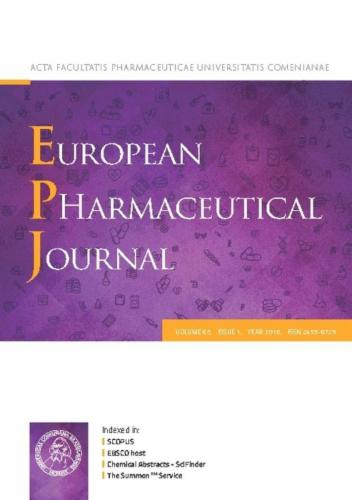Towards implementing optimized methodologies and in-depth molecular profiling to assess the pharmacological potential of human lung fibroblast exosomes as bio-shuttles for cancer therapeutics
IF 4.7
3区 医学
Q1 PHARMACOLOGY & PHARMACY
引用次数: 0
Abstract
Despite their favorable biopharmaceutical properties, exosomes face standardization challenges in isolation and characterization, hindering the development of EV products suitable for clinical applications. The MRC-5 cell line poses a cellular model approved by regulatory affairs for drug development, facilitating the clinical translation of MRC-5 cell-derived nanotherapeutics. This study aims to: (a) identify the optimal methodology for isolating intact MRC-5 cell-derived exosomes with high purity and integrity suitable for drug delivery applications, (b) elucidate the global miRNA and proteomic profile of the isolated exosomes using high-throughput methodologies and bioinformatics, (c) investigate the exosome uptake capacity towards the “autologous” normal MRC-5, and “heterologous” malignant human lung adenocarcinoma A549 and tongue squamous HSC-3 cells, (d) evaluate the pharmacological profile of doxorubicin (DOX)- and curcumin (CUR)- loaded exosomes towards the normal and tumorigenic cells in vitro. The proposed isolation protocol combining ultrafiltration with membrane-based affinity binding, yielded non-aggregated exosomes with superior physicochemical properties. The miRNA profiling data revealed the enrichment of several tumor-suppressive miRNAs mainly involved in gene regulation pathways, whilst the proteomic profiling highlighted the role of exosomal protein in extracellular matrix remodeling. The drug delivery profiling indicated an “intrinsic” tropism of the exosomes towards the malignant A549 and HSC-3 cells. Exosomal CUR and exosomal DOX inhibited tumor cell proliferation more efficiently than free drugs, with synergistic effects upon co-administration. This study provides a comprehensive morphological, physicochemical and molecular characterization of MRC-5 cell-derived exosomes and validates the “intrinsic” tropism of CUR- and DOX- loaded exosomes towards tumorigenic cells, paving the way towards their further exploitation as drug delivery nanocarriers.

实施优化的方法和深入的分子谱来评估人肺成纤维细胞外泌体作为癌症治疗的生物穿梭体的药理学潜力。
尽管外泌体具有良好的生物制药特性,但在分离和表征方面面临标准化挑战,阻碍了适合临床应用的EV产品的开发。MRC-5细胞系形成了一个经监管机构批准的用于药物开发的细胞模型,促进了MRC-5细胞衍生的纳米治疗药物的临床转化。本研究旨在:(a)确定分离完整MRC-5细胞来源的外泌体的最佳方法,具有高纯度和完整性,适合于药物输送应用;(b)利用高通量方法和生物信息学阐明分离的外泌体的全球miRNA和蛋白质组学谱;(c)研究外泌体对“自体”正常MRC-5、“异源”恶性人肺腺癌A549和舌鳞HSC-3细胞的摄取能力。(d)评估多柔比星(DOX)和姜黄素(CUR)负载外泌体对体外正常细胞和致瘤细胞的药理学特征。所提出的分离方案结合超滤和基于膜的亲和结合,获得了具有优越物理化学性质的非聚集外泌体。miRNA分析数据揭示了几种主要参与基因调控途径的肿瘤抑制miRNA的富集,而蛋白质组学分析强调了外泌体蛋白在细胞外基质重塑中的作用。药物传递谱表明外泌体对恶性A549和HSC-3细胞具有“内在的”趋向性。外泌体CUR和外泌体DOX比游离药物更有效地抑制肿瘤细胞增殖,在共给药时具有协同作用。本研究提供了MRC-5细胞源性外泌体的全面形态学、物理化学和分子特征,并验证了CUR-和DOX-负载外泌体对致瘤细胞的“内在”倾向,为进一步开发它们作为药物递送纳米载体铺平了道路。
本文章由计算机程序翻译,如有差异,请以英文原文为准。
求助全文
约1分钟内获得全文
求助全文
来源期刊
CiteScore
9.60
自引率
2.20%
发文量
248
审稿时长
50 days
期刊介绍:
The journal publishes research articles, review articles and scientific commentaries on all aspects of the pharmaceutical sciences with emphasis on conceptual novelty and scientific quality. The Editors welcome articles in this multidisciplinary field, with a focus on topics relevant for drug discovery and development.
More specifically, the Journal publishes reports on medicinal chemistry, pharmacology, drug absorption and metabolism, pharmacokinetics and pharmacodynamics, pharmaceutical and biomedical analysis, drug delivery (including gene delivery), drug targeting, pharmaceutical technology, pharmaceutical biotechnology and clinical drug evaluation. The journal will typically not give priority to manuscripts focusing primarily on organic synthesis, natural products, adaptation of analytical approaches, or discussions pertaining to drug policy making.
Scientific commentaries and review articles are generally by invitation only or by consent of the Editors. Proceedings of scientific meetings may be published as special issues or supplements to the Journal.

 求助内容:
求助内容: 应助结果提醒方式:
应助结果提醒方式:


